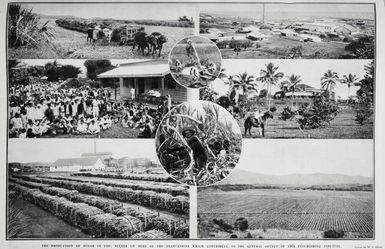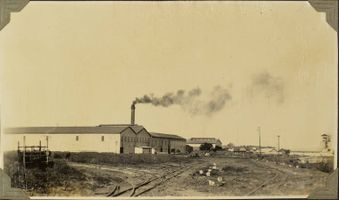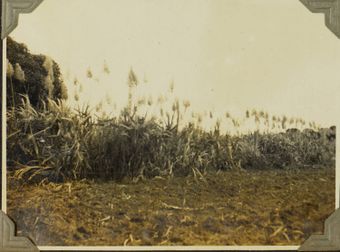The production of sugar in Fiji
- Description:
- Showing a montage of eight photographs showing scenes on some of the sugar plantations in Fiji which contribute to general output of this flourishing industry. The captions of the photographs: 1. Hauling cane from the field to the main tram line, where it is taken to the mill by steam engines. 2. General view of the Colonial Sugar Refining Company's mill at Lautoka, showing a steamer at the wharf loading sugar, and the men's quarters in the foreground. 3. Labourer's waiting payment at one of the mills. 4. Plough drawn by steam traction engine breaking up ground for planting the cane. 5. A planter's residence. 6. The Colonial Sugar Refinery's crushing mill at Lautoka, showing train loads of cane waiting to be treated. 7. Cutting sugar cane on an estate at Nadi. 8. A field of young sugar cane.
- Display date:
- 1914-12-03
- Location:
- Fiji
- Collections:
- Auckland Weekly News
- Content partner:
- Auckland Libraries
- Availability:
- Not specified
-
Copyright status: Share, modifyFind out more about what you are able to do with this itemMore informationAuckland Libraries has this to say about the rights status of this item:
No known copyright restrictions
What can I do with this item?Non-infringing useNZ copyright law does not prevent every use of a copyright work, and this item may be hosted by an international institute or organisation. You should consider what you can and cannot do with a copyright work.Share itThis item is suitable for copying and sharing with others, without further permission.Modify itThis item is suitable for modifying, remixing and building upon, without further permission.Check about commercial useYou'll need to confirm with the copyright holder using this item for commercial purposes.
Welcome and warm Pasifik greetings
The information on this site has been gathered from our content partners.
The names, terms, and labels that we present on the site may contain images or voices of deceased persons and may also reflect the bias, norms, and perspective of the period of time in which they were created. We accept that these may not be appropriate today.
If you have any concerns or questions about an item, please contact us.


